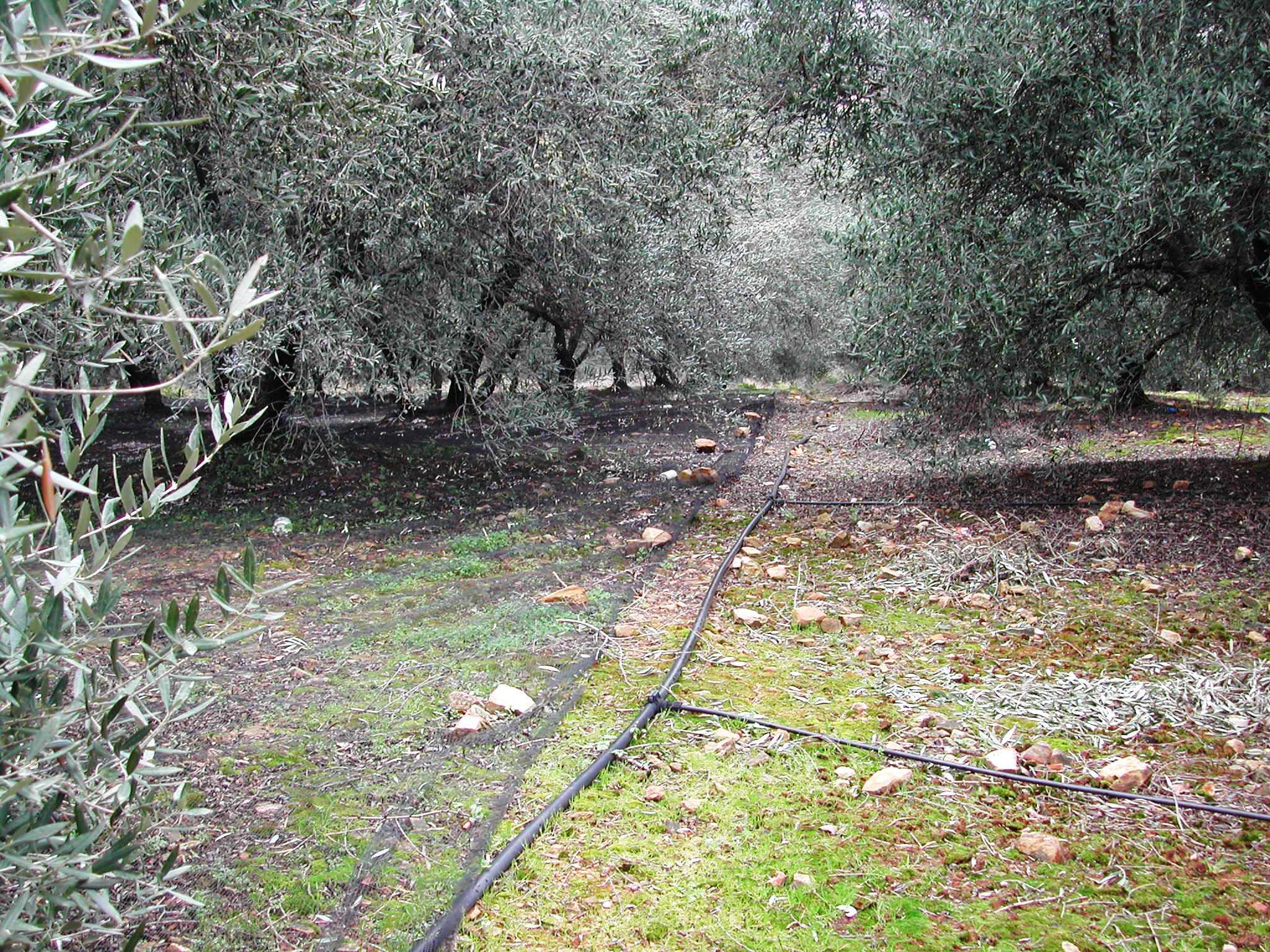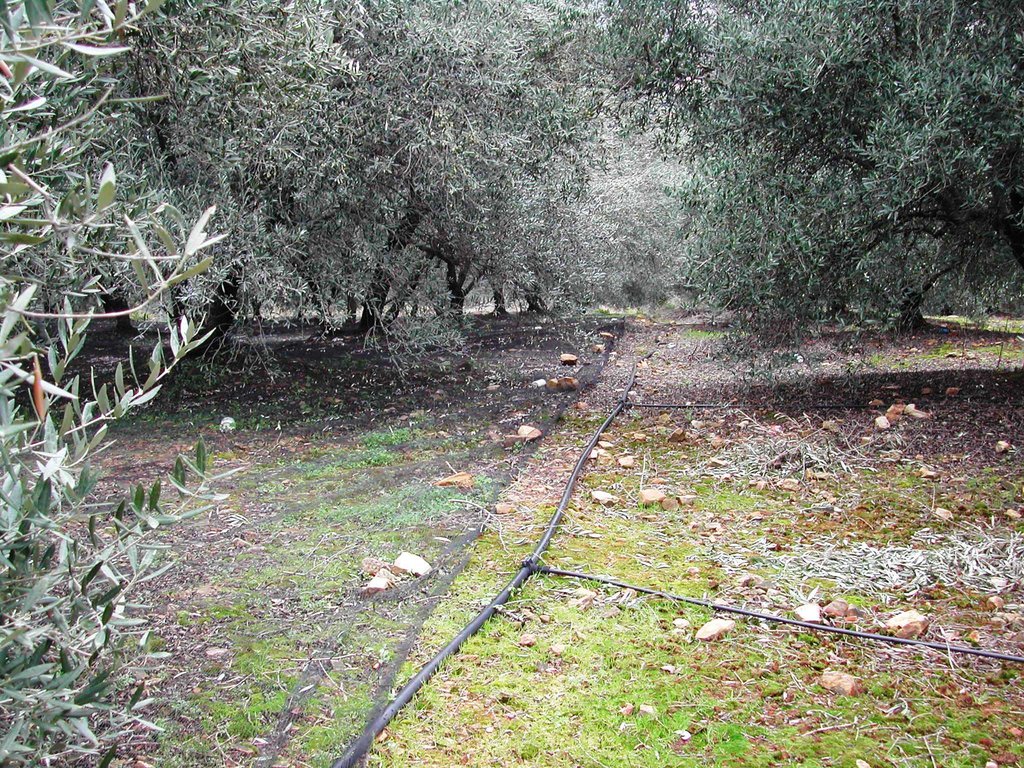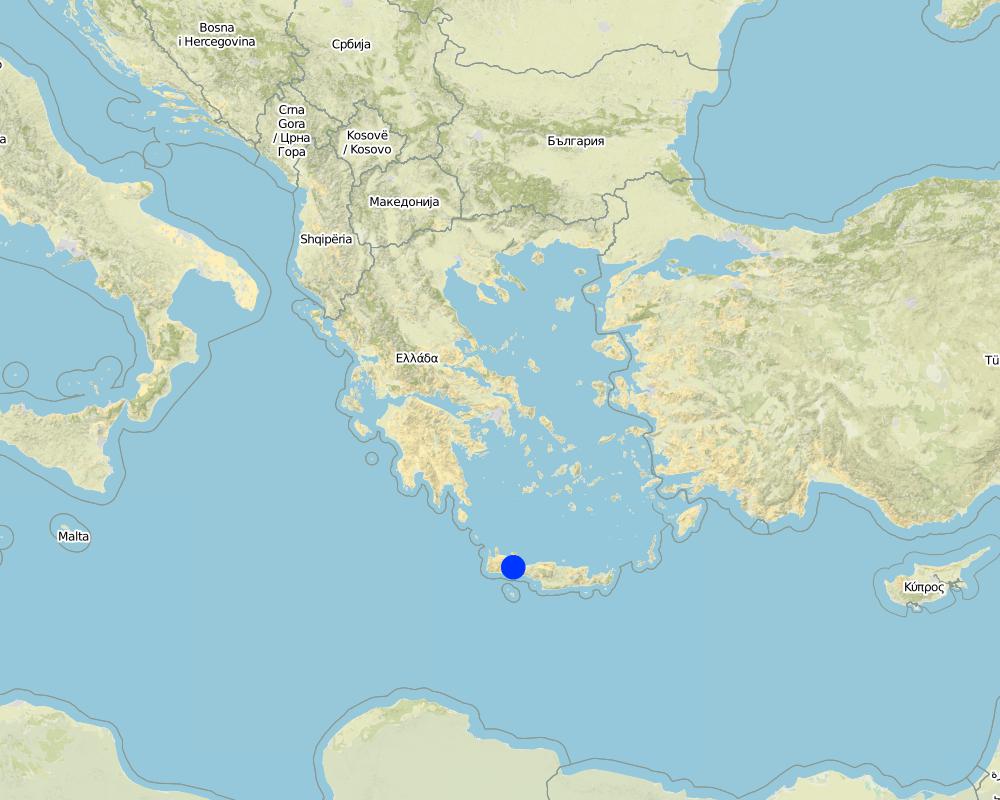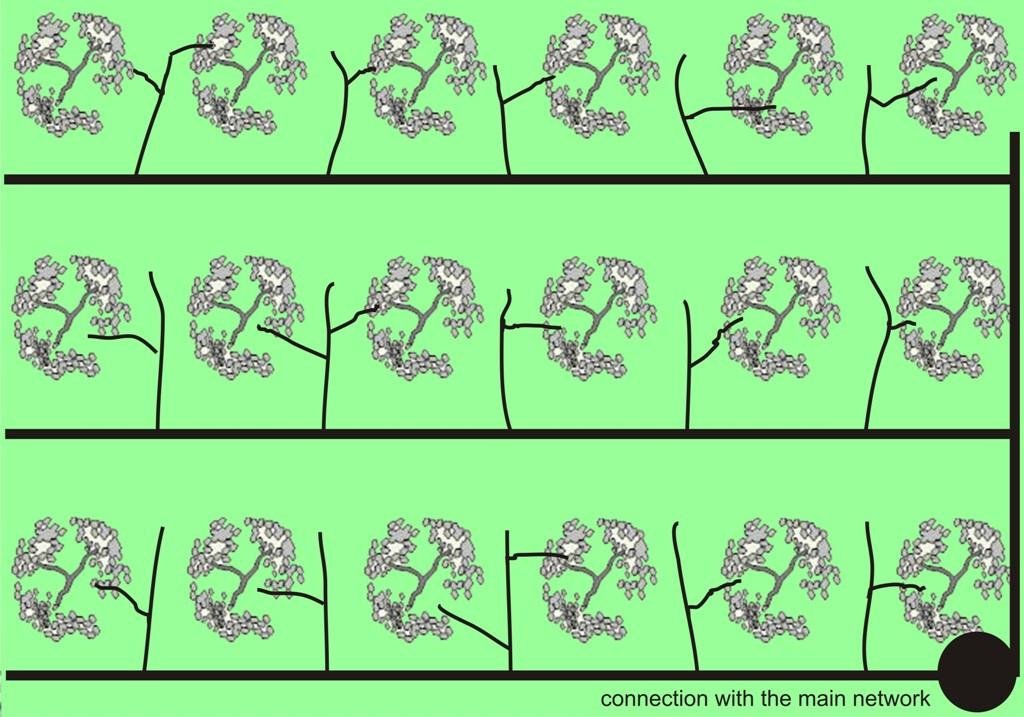Application of water by drip irrigation [กรีซ]
- ผู้สร้างสรรค์:
- การอัพเดท:
- ผู้รวบรวม: Costas Kosmas
- ผู้เรียบเรียง: –
- ผู้ตรวจสอบ: Fabian Ottiger, Alexandra Gavilano
Αρδευση με σταγονες
technologies_1456 - กรีซ
ดูส่วนย่อย
ขยายทั้งหมด ย่อทั้งหมด1. ข้อมูลทั่วไป
1.2 รายละเอียดที่ติดต่อได้ของผู้รวบรวมและองค์กรที่เกี่ยวข้องในการประเมินและการจัดเตรียมทำเอกสารของเทคโนโลยี
ผู้เชี่ยวชาญ SLM:
Bardoulaki-Spanoudaki G
Organization for the Development of Western Crete OADYK Agia, Chania
กรีซ
ชื่อขององค์กรซึ่งอำนวยความสะดวกในการทำเอกสารหรือการประเมินเทคโนโลยี (ถ้าเกี่ยวข้อง)
Agricultural University of Athens (AUAb) - กรีซชื่อขององค์กรซึ่งอำนวยความสะดวกในการทำเอกสารหรือการประเมินเทคโนโลยี (ถ้าเกี่ยวข้อง)
Organization for the Development of Western Crete (OADYK) - กรีซ1.3 เงื่อนไขการใช้ข้อมูลที่ได้บันทึกผ่านทาง WOCAT
ผู้รวบรวมและวิทยากรหลักยอมรับเงื่อนไขเกี่ยวกับการใช้ข้อมูลที่ถูกบันทึกผ่านทาง WOCAT:
ใช่
1.5 Reference to Questionnaire(s) on SLM Approaches (documented using WOCAT)
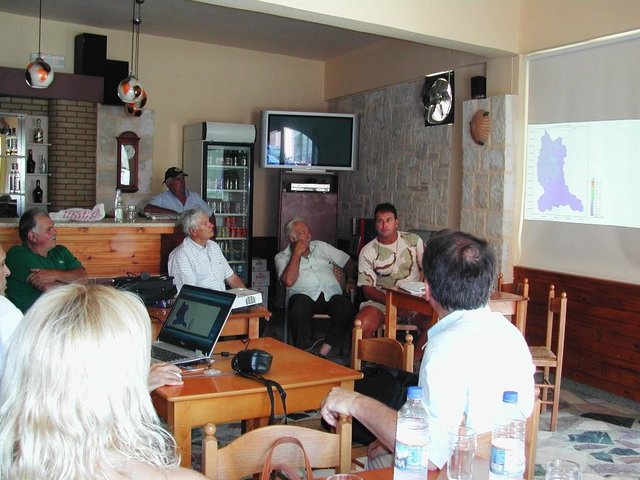
Sustainable use of water [กรีซ]
Sustainable use of water
- ผู้รวบรวม: Costas Kosmas
2. การอธิบายลักษณะของเทคโนโลยี SLM
2.1 การอธิบายแบบสั้น ๆ ของเทคโนโลยี
คำจำกัดความของเทคโนโลยี:
Drip irrigation, also known as trickle irrigation is a method which minimizes the use of water and fertilizer by allowing water to drip slowly to the roots of plants, either onto the soil surface or directly onto the root zone, through a network of valves, pipes, tubing, and emitters.
2.2 การอธิบายแบบละเอียดของเทคโนโลยี
คำอธิบาย:
Irrigation is very important for increasing crop yields in arid, semi-arid and dry sub-humid climates. The area of irrigated land has increased more than twice in the last decades in the study areas. In recent years, the considerable reduction of winter and autumn rainfall has caused a serious lack of water resources. The production of the various crops is substantially reduced if water is not provided during the summer period.
The high demands for water consumption or other economic activities have increased the price of water, forcing up the cost of agricultural production. In addition, in many cases, low quality (with high electrical conductivity) water is used for irrigation. The need for intensification of agriculture to meet the high cost of production, the use of poor quality of water, the lack of drainage systems are in many cases responsible for soil degradation resulting from water logging, salinization, alkalinization, and soil erosion.
Purpose of the Technology: Drip or trickle irrigation achieves the highest irrigation efficiency since about 90% of the applied water is available to the plants. This SWC technology is especially suitable for watering trees or other large plants keeping strips among trees dry. Application of water by drip irrigation can be considered more as more efficient method using low quality of irrigation water. Irrigation water of high salt content can be applied in higher quantities in spots leaching salts to deeper soil layers. Drip irrigation can be applied in any type of soil from coarse- and fine-textured and without any limitation to slope gradient requiring little labour during installation.
Establishment / maintenance activities and inputs: In the study area of Chania trickle irrigation system includes mainly three branches from the outlet of main water network transportation system to the application in the trees. The last branch consists of plastic tube 12 to 32 mm in diameter that lies either on or just below the soil surface and applies the water either through small holes in the line or through emitter nozzle.
Natural / human environment: In recent years the increasing awareness of farmers on issues relating to the sustainability of the environment and conservation of water by promoting SWC technologies has led to widespread of use of drip irrigation in the area of Crete and in many other parts of the Country. The categorization of the specific SWC technology according to the WOCAT questionnaire is defined as: CtWtA3.
2.3 รูปภาพของเทคโนโลยี
2.5 ประเทศภูมิภาค หรือสถานที่ตั้งที่เทคโนโลยีได้นำไปใช้และได้รับการครอบคลุมโดยการประเมินนี้
ประเทศ:
กรีซ
ภูมิภาค/รัฐ/จังหวัด:
Kidonia
ข้อมูลจำเพาะเพิ่มเติมของสถานที่ตั้ง :
Chania Crete
แสดงความคิดเห็น:
Total area covered by the SLM Technology is 480 km2.
Map
×2.7 คำแนะนำของเทคโนโลยี
ให้ระบุว่าเทคโนโลยีถูกแนะนำเข้ามาอย่างไร:
- ในช่วงการทดลองหรือการทำวิจัย
3. การจัดประเภทของเทคโนโลยี SLM
3.2 ประเภทของการใช้ที่ดินในปัจจุบันที่ได้นำเทคโนโลยีไปใช้

พื้นที่ปลูกพืช
- การปลูกไม้ยืนต้น ไม้พุ่ม
Tree and shrub cropping - Specify crops:
- olive
ระบุ:
Longest growing period in days: 120Longest growing period from month to month: March to JuneSecond longest growing period in days: 150Second longest growing period from month to month: March to June
แสดงความคิดเห็น:
Major land use problems (compiler’s opinion): availability of irrigation water, loss of water in the network, conflicts between districts and economic sectors of tourism and agriculure
Major land use problems (land users’ perception): availability of irrigation water, conflicts between districts and economic sectors of tourism and agriculure
Livestock is grazing on crop residues
3.4 การใช้น้ำ
การใช้น้ำของที่ดินที่มีการใช้เทคโนโลยีอยู่:
- น้ำฝนร่วมกับการชลประทาน
3.5 กลุ่ม SLM ที่ตรงกับเทคโนโลยีนี้
- การจัดการด้านชลประทาน (รวมถึงการลำเลียงส่งน้ำ การระบายน้ำ)
3.6 มาตรการ SLM ที่ประกอบกันเป็นเทคโนโลยี

มาตรการจัดการพืช
- A3: การรักษาหน้าดิน

มาตรการอนุรักษ์ด้วยโครงสร้าง
- S11: อื่น ๆ
แสดงความคิดเห็น:
Main measures: agronomic measures
Secondary measures: structural measures
Type of vegetative measures: in blocks
3.7 รูปแบบหลักของการเสื่อมโทรมของที่ดินที่ได้รับการแก้ไขโดยเทคโนโลยี

การเสื่อมโทรมของน้ำ
- Ha (Aridification): การเกิดความแห้งแล้ง
แสดงความคิดเห็น:
Main type of degradation addressed: Ha: aridification
Main causes of degradation: disturbance of water cycle (infiltration / runoff) (lack of water), education, access to knowledge and support services (lack of knowledge)
Secondary causes of degradation: over abstraction / excessive withdrawal of water (for irrigation, industry, etc.) (salinization)
3.8 การป้องกัน การลดลง หรือการฟื้นฟูความเสื่อมโทรมของที่ดิน
ระบุเป้าหมายของเทคโนโลยีกับความเสื่อมโทรมของที่ดิน:
- ป้องกันความเสื่อมโทรมของที่ดิน
แสดงความคิดเห็น:
Secondary goals: prevention of land degradation
4. ข้อมูลจำเพาะด้านเทคนิค กิจกรรมการนำไปปฏิบัติใช้ ปัจจัยนำเข้า และค่าใช้จ่าย
4.1 แบบแปลนทางเทคนิคของเทคโนโลยี
ข้อมูลจำเพาะด้านเทคนิค (แบบแปลนทางเทคนิคของเทคโนโลยี):
In the study area of Chania trickle irrigation system includes mainly three branches from the outlet of main water network transportation system to the application in the trees. The last branch consists of plastic tube 12 to 32 mm in diameter that lies either on or just below the soil surface and applies the water either through small holes in the line or through emitter nozzles.
Location: Kasteli. Chania
Date: March 2007
Technical knowledge required for land users: moderate (system installation requirements)
Main technical functions: improvement of ground cover
Secondary technical functions: increase in organic matter, increase of biomass (quantity)
In blocks
Vegetative material: C : perennial crops
Number of plants per (ha): 250
Vertical interval between rows / strips / blocks (m): 5
Spacing between rows / strips / blocks (m): 5
Vertical interval within rows / strips / blocks (m): 5
Width within rows / strips / blocks (m): 4
Perennial crops species: olives
Slope (which determines the spacing indicated above): 15.00%
Gradient along the rows / strips: 15.00%
Structural measure: irrigation system
Spacing between structures (m): 8
Construction material (other): plastic, plastic tubes 12-32 mm in diameter
Other type of management: Water distribution among farmers, water is provided under the control of local authorities
ผู้เขียน:
C. Kosmas
4.3 กิจกรรมเพื่อการจัดตั้ง
| กิจกรรม | Timing (season) | |
|---|---|---|
| 1. | planting the olive trees | 2 days/ha |
| 2. | transporting plastic tubes | once during installation |
| 3. | Whole system of tubes, filters and system of fertilizers application | once during installation |
| 4. | Main network of irrigation system | once per year |
4.4 ค่าใช้จ่ายของปัจจัยนำเข้าที่จำเป็นสำหรับการจัดตั้ง
| ปัจจัยนำเข้า | หน่วย | ปริมาณ | ค่าใช้จ่ายต่อหน่วย | ค่าใช้จ่ายทั้งหมดต่อปัจจัยนำเข้า | %ของค่าใช้จ่ายที่ก่อให้เกิดขึ้นโดยผู้ใช้ที่ดิน | |
|---|---|---|---|---|---|---|
| แรงงาน | >Installation | ha | 1.0 | 350.0 | 350.0 | |
| อุปกรณ์ | Tools | ha | 1.0 | 1650.0 | 1650.0 | |
| ค่าใช้จ่ายทั้งหมดของการจัดตั้งเทคโนโลยี | 2000.0 | |||||
| Total costs for establishment of the Technology in USD | 2000.0 | |||||
แสดงความคิดเห็น:
Duration of establishment phase: 0.1 month(s)
Life span of the irrigation network: 20 years
4.5 การบำรุงรักษาสภาพหรือกิจกรรมที่เกิดขึ้นเป็นประจำ
| กิจกรรม | ช่วงระยะเวลา/ความถี่ | |
|---|---|---|
| 1. | cleaning filters and replacing destroyied tubes | 3 hours every year/ha |
| 2. | Checking outlets and conectors | once per year |
| 3. | Control of network for loss of irrigation water | once per year |
4.6 ค่าใช้จ่ายของปัจจัยนำเข้าและกิจกรรมที่เกิดขึ้นเป็นประจำที่ต้องการการบำรุงรักษา (ต่อปี)
| ปัจจัยนำเข้า | หน่วย | ปริมาณ | ค่าใช้จ่ายต่อหน่วย | ค่าใช้จ่ายทั้งหมดต่อปัจจัยนำเข้า | %ของค่าใช้จ่ายที่ก่อให้เกิดขึ้นโดยผู้ใช้ที่ดิน | |
|---|---|---|---|---|---|---|
| แรงงาน | Labour | ha | 1.0 | 10.0 | 10.0 | |
| อุปกรณ์ | Tools | ha | 1.0 | 50.0 | 50.0 | |
| ค่าใช้จ่ายทั้งหมดของการบำรุงรักษาสภาพเทคโนโลยี | 60.0 | |||||
| Total costs for maintenance of the Technology in USD | 60.0 | |||||
แสดงความคิดเห็น:
Machinery/ tools: hand tools, System of applying fertilizers through the irrigation water, filters for keeping various solid materials
per hectare of land affected
4.7 ปัจจัยสำคัญที่สุดที่มีผลกระทบต่อค่าใช้จ่าย
ปัจจัยสำคัญที่สุดที่มีผลกระทบต่อค่าใช้จ่ายต่างๆ:
the reguired materials (tubes, filters, etc)
5. สิ่งแวดล้อมทางธรรมชาติและของมนุษย์
5.1 ภูมิอากาศ
ฝนประจำปี
- < 250 ม.ม.
- 251-500 ม.ม.
- 501-750 ม.ม.
- 751-1,000 ม.ม.
- 1,001-1,500 ม.ม.
- 1,501-2,000 ม.ม.
- 2,001-3,000 ม.ม.
- 3,001-4,000 ม.ม.
- > 4,000 ม.ม.
ข้อมูลจำเพาะ/ความคิดเห็นเรื่องปริมาณน้ำฝน:
With six months of dry period
เขตภูมิอากาศเกษตร
- กึ่งชุ่มชื้น
- กึ่งแห้งแล้ง
Thermal climate class: temperate
5.2 สภาพภูมิประเทศ
ค่าเฉลี่ยความลาดชัน:
- ราบเรียบ (0-2%)
- ลาดที่ไม่ชัน (3-5%)
- ปานกลาง (6-10%)
- เป็นลูกคลื่น (11-15%)
- เป็นเนิน (16-30%)
- ชัน (31-60%)
- ชันมาก (>60%)
ธรณีสัณฐาน:
- ที่ราบสูง/ที่ราบ
- สันเขา
- ไหล่เขา
- ไหล่เนินเขา
- ตีนเนิน
- หุบเขา
ระดับความสูง:
- 0-100 เมตร
- 101-500 เมตร
- 501-1,000 เมตร
- 1,001-1,500 เมตร
- 1,501-2,000 เมตร
- 2,001-2,500 เมตร
- 2,501-3,000 เมตร
- 3,001-4,000 เมตร
- > 4,000 เมตร
5.3 ดิน
ค่าเฉลี่ยความลึกของดิน:
- ตื้นมาก (0-20 ซ.ม.)
- ตื้น (21-50 ซ.ม.)
- ลึกปานกลาง (51-80 ซ.ม.)
- ลึก (81-120 ซ.ม.)
- ลึกมาก (>120 ซ.ม.)
เนื้อดิน (ดินชั้นบน):
- ปานกลาง (ดินร่วน ทรายแป้ง)
อินทรียวัตถุในดิน:
- สูง (>3%)
- ปานกลาง (1-3%)
(ถ้ามี) ให้แนบคำอธิบายเรื่องดินแบบเต็มหรือระบุข้อมูลที่มีอยู่ เช่น ชนิดของดิน ค่า pH ของดินหรือความเป็นกรดของดิน ความสามารถในการแลกเปลี่ยนประจุบวก ไนโตรเจน ความเค็ม เป็นต้น:
Soil fertility is very high-medium
Soil drainage/infiltration is good
Soil water storage capacity is high-very high
5.4 ความเป็นประโยชน์และคุณภาพของน้ำ
น้ำไหลบ่าที่ผิวดิน:
ดี
ความคิดเห็นและข้อมูลจำเพาะเพิ่มเติมเรื่องคุณภาพและปริมาณน้ำ:
Ground water table: 5-50 m, > 50 m
Water quality (untreated): good drinking water, for agricultural use only (irrigation)
5.5 ความหลากหลายทางชีวภาพ
ความหลากหลายทางชนิดพันธุ์:
- สูง
5.6 ลักษณะของผู้ใช้ที่ดินที่นำเทคโนโลยีไปปฏิบัติใช้
แนวทางการตลาดของระบบการผลิต:
- mixed (subsistence/ commercial)
รายได้ที่มาจากนอกฟาร์ม:
- < 10% ของรายได้ทั้งหมด
ระดับของความมั่งคั่งโดยเปรียบเทียบ:
- พอมีพอกิน
- รวย
เป็นรายบุคคล/ครัวเรือน:
- เป็นรายบุคคล/ครัวเรือน
ระดับของการใช้เครื่องจักรกล:
- การใช้เครื่องจักรหรือเครื่องยนต์
เพศ:
- ชาย
ระบุลักษณะอื่นๆที่เกี่ยวข้องของผู้ใช้ที่ดิน:
Land users applying the Technology are mainly common / average land users
Difference in the involvement of women and men: Women in rural areas are involved in other type of work
Population density: 10-50 persons/km2
Annual population growth: 1% - 2%
5% of the land users are rich (cost for buying materials).
55% of the land users are average wealthy.
Off-farm income specification: working in tourist business
5.7 Average area of land used by land users applying the Technology
- < 0.5 เฮกตาร์
- 0.5-1 เฮกตาร์
- 1-2 เฮกตาร์
- 2-5 เฮกตาร์
- 5-15 เฮกตาร์
- 15-50 เฮกตาร์
- 50-100 เฮกตาร์
- 100-500 เฮกตาร์
- 500-1,000 เฮกตาร์
- 1,000-10,000 เฮกตาร์
- >10,000 เฮกตาร์
พิจารณาว่าเป็นขนาดเล็ก กลาง หรือขนาดใหญ่ (ซึ่งอ้างอิงถึงบริบทระดับท้องถิ่น):
- ขนาดเล็ก
5.8 กรรมสิทธิ์ในที่ดิน สิทธิในการใช้ที่ดินและสิทธิในการใช้น้ำ
กรรมสิทธิ์ในที่ดิน:
- รายบุคคล ได้รับสิทธิครอบครอง
สิทธิในการใช้ที่ดิน:
- เช่า
- รายบุคคล
สิทธิในการใช้น้ำ:
- เกี่ยวกับชุมชน (ถูกจัดระเบียบ)
- รายบุคคล
5.9 การเข้าถึงบริการและโครงสร้างพื้นฐาน
ความช่วยเหลือทางด้านเทคนิค:
- จน
- ปานกลาง
- ดี
ตลาด:
- จน
- ปานกลาง
- ดี
ถนนและการขนส่ง:
- จน
- ปานกลาง
- ดี
บริการด้านการเงิน:
- จน
- ปานกลาง
- ดี
6. ผลกระทบและสรุปคำบอกกล่าว
6.1 ผลกระทบในพื้นที่ดำเนินการ (On-site) จากการใช้เทคโนโลยี
ผลกระทบทางด้านเศรษฐกิจและสังคม
การผลิต
การผลิตพืชผล
จำนวนก่อน SLM:
1500 kg/ha
หลังจาก SLM:
2000 kg/ha
การจัดการที่ดิน
แสดงความคิดเห็น/ระบุ:
Cultivation of the land is hindered by the irrigation network
ความเป็นประโยชน์และคุณภาพของน้ำ
การมีน้ำไว้ให้สำหรับการชลประทาน
คุณภาพน้ำสำหรับการชลประทาน
รายได้และค่าใช้จ่าย
ค่าใช่จ่ายของปัจจัยการผลิตทางการเกษตร
รายได้จากฟาร์ม
จำนวนก่อน SLM:
4500 euro/ha
หลังจาก SLM:
5800 euro/ha
ภาระงาน
ผลกระทบด้านสังคมวัฒนธรรมอื่น ๆ
โอกาสทางวัฒนธรรม
สถานการณ์ของกลุ่มด้อยโอกาส ทางด้านสังคมและเศรษฐกิจ
Improved livelihoods and human well-being
แสดงความคิดเห็น/ระบุ:
Significant environmental benefit from the rational use of irrigation water
ผลกระทบด้านนิเวศวิทยา
ดิน
ความชื้นในดิน
ความเค็ม
ความหลากหลายทางชีวภาพของพืชและสัตว์
มวลชีวภาพ/เหนือดินชั้น C
ผลกระทบด้านนิเวศวิทยาอื่น ๆ
Waste
แสดงความคิดเห็น/ระบุ:
environmental pollution due to presence of plastics not easily recycled
6.2 ผลกระทบนอกพื้นที่ดำเนินการ (Off-site) จากการใช้เทคโนโลยี
น้ำที่ใช้ประโยชน์ได้
6.3 การเผชิญและความตอบสนองของเทคโนโลยีต่อการเปลี่ยนแปลงสภาพภูมิอากาศที่ค่อยเป็นค่อยไป และสภาพรุนแรงของภูมิอากาศ / ภัยพิบัติ (ที่รับรู้ได้โดยผู้ใช้ที่ดิน)
สภาพรุนแรงของภูมิอากาศ (ภัยพิบัติ)
ภัยพิบัติจากน้ำ
| เทคโนโลยีมีวิธีการรับมืออย่างไร | |
|---|---|
| น้ำท่วมตามปกติ (แม่น้ำ) | ไม่ค่อยดี |
แสดงความคิดเห็น:
Control of flooding by adjusting river bed
6.4 การวิเคราะห์ค่าใช้จ่ายและผลประโยชน์ที่ได้รับ
ผลประโยชน์ที่ได้รับเปรียบเทียบกับค่าใช้จ่ายในการจัดตั้งเป็นอย่างไร (จากมุมมองของผู้ใช้ที่ดิน)
ผลตอบแทนระยะสั้น:
ด้านบวก
ผลตอบแทนระยะยาว:
ด้านบวก
ผลประโยชน์ที่ได้รับเปรียบเทียบกับค่าใช้จ่ายในการบำรุงรักษาหรือต้นทุนที่เกิดขึ้นซ้ำอีก เป็นอย่างไร (จากมุมมองของผู้ใช้ที่ดิน)
ผลตอบแทนระยะสั้น:
ด้านบวก
ผลตอบแทนระยะยาว:
ด้านบวก
6.5 การปรับตัวของเทคโนโลยี
ถ้ามีข้อมูลให้บอกปริมาณด้วย (จำนวนของครัวเรือนหรือครอบคลุมพื้นที่):
3850
Of all those who have adopted the Technology, how many did so spontaneously, i.e. without receiving any material incentives/ payments?
- 11-50%
แสดงความคิดเห็น:
65% of land user families have adopted the Technology with external material support
2200 land user families have adopted the Technology with external material support
35% of land user families have adopted the Technology without any external material support
1650 land user families have adopted the Technology without any external material support
There is a moderate trend towards spontaneous adoption of the Technology
6.7 จุดแข็ง / ข้อได้เปรียบ / โอกาสของเทคโนโลยี
| จุดแข็ง / ข้อได้เปรียบ / โอกาสในทัศนคติของผู้ใช้ที่ดิน |
|---|
|
Increase crop production in some cases up to 50% How can they be sustained / enhanced? providing more water |
| จุดแข็ง / ข้อได้เปรียบ / โอกาสในทัศนคติของผู้รวบรวมหรือวิทยากรหลัก |
|---|
|
Technologies on conserving soil and water resources and combating desertification in Crete are mainly related to land management. Olive groves are widely expanded in the island due to the importance of olive oil as one of the essential material for daily human food needs. Furthermore, olive groves can survive under adverse climatic and soil conditions supporting a significant farmer’s income under relatively low labour. Land management practices have been adopted in the area based on tradition and transfer knowledge by the local institutes and specialists. In addition, irrigation of the land by the drip system is considered as a very promising technique for conserving water resources in the area. Land terracing is a human intervention in sloping semi-natural landscapes, which have suffered losses, to some degree, in their sustainability and resilience. How can they be sustained / enhanced? by providing additional water resources in the area (build a water reservoir) |
6.8 จุดอ่อน / ข้อเสียเปรียบ / ความเสี่ยงของเทคโนโลยีและวิธีการแก้ไข
| จุดอ่อน / ข้อเสียเปรียบ / ความเสี่ยงในทัศนคติของผู้ใช้ที่ดิน | มีวิธีการแก้ไขได้อย่างไร |
|---|---|
| High cost for buying materials, better education | subsidizing materials, technology transfer |
| จุดอ่อน / ข้อเสียเปรียบ / ความเสี่ยงในทัศนคติของผู้รวบรวมหรือวิทยากรหลัก | มีวิธีการแก้ไขได้อย่างไร |
|---|---|
| increased cost for the first installation | subsidizing the system |
7. การอ้างอิงและการเชื่อมต่อ
7.1 วิธีการและแหล่งข้อมูล
ลิงก์และโมดูล
ขยายทั้งหมด ย่อทั้งหมดลิงก์

Sustainable use of water [กรีซ]
Sustainable use of water
- ผู้รวบรวม: Costas Kosmas
โมดูล
ไม่มีโมดูล


